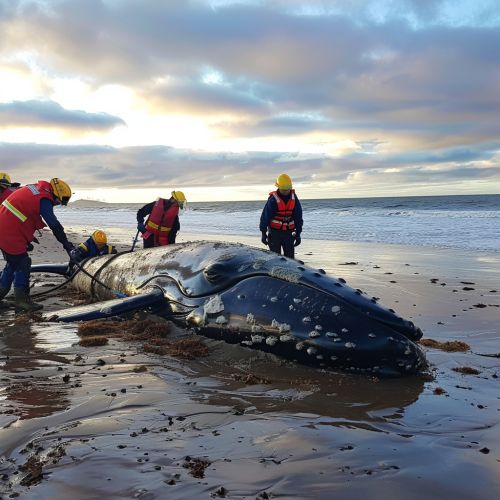Cetacean stranding: Difference between revisions
(Created page with "== Introduction == Cetacean stranding, also known as beaching, refers to the phenomenon where cetaceans (whales, dolphins, and porpoises) strand themselves on land, usually on a beach. This event can involve a single animal or a group, and it has been a subject of scientific investigation for many years due to its complex and multifaceted nature. Stranding events can result in the death of the animals if they are not returned to the water promptly, and the reasons behin...") |
No edit summary |
||
| Line 59: | Line 59: | ||
Rescue operations aim to return stranded cetaceans to the water. This can involve physically moving the animals using specialized equipment and techniques. In some cases, temporary holding pens are used to stabilize the animals before release. | Rescue operations aim to return stranded cetaceans to the water. This can involve physically moving the animals using specialized equipment and techniques. In some cases, temporary holding pens are used to stabilize the animals before release. | ||
[[Image:Detail-79653.jpg|thumb|center|Rescue team assisting a stranded whale on a beach.]] | |||
=== Post-Rescue Monitoring === | === Post-Rescue Monitoring === | ||
Revision as of 12:50, 19 May 2024
Introduction
Cetacean stranding, also known as beaching, refers to the phenomenon where cetaceans (whales, dolphins, and porpoises) strand themselves on land, usually on a beach. This event can involve a single animal or a group, and it has been a subject of scientific investigation for many years due to its complex and multifaceted nature. Stranding events can result in the death of the animals if they are not returned to the water promptly, and the reasons behind these occurrences are varied and often not fully understood.
Types of Stranding
Cetacean strandings can be categorized into two main types: single strandings and mass strandings.
Single Strandings
Single strandings involve one cetacean and are more common than mass strandings. These events can occur due to various reasons, including illness, injury, navigational errors, or extreme weather conditions. Single strandings are often easier to manage and can sometimes be resolved by guiding the animal back to deeper waters.
Mass Strandings
Mass strandings involve multiple cetaceans and are less common but more complex. These events can involve dozens or even hundreds of animals and are often more challenging to address. Mass strandings are particularly perplexing to scientists and can be influenced by social structures within cetacean pods, environmental factors, and human activities.
Causes of Stranding
The causes of cetacean stranding are diverse and can be broadly categorized into natural and anthropogenic factors.
Natural Causes
Illness and Injury
Cetaceans can strand due to illness or injury. Diseases, parasites, and physical trauma can impair their ability to navigate and survive in their natural habitat. For instance, infections caused by viruses such as morbillivirus have been linked to stranding events.
Navigational errors can occur due to various reasons, including geomagnetic anomalies, which can disrupt the cetaceans' ability to navigate using the Earth's magnetic field. Additionally, shallow coastal areas can confuse cetaceans, leading them to strand.
Social Cohesion
Cetaceans are highly social animals, and their strong social bonds can lead to mass strandings. If a leader or a significant number of individuals in a pod strand, others may follow due to their social cohesion.
Anthropogenic Causes
Noise Pollution
Human activities, such as naval exercises and seismic surveys, generate underwater noise that can disrupt cetaceans' echolocation and communication. This noise pollution can cause disorientation and lead to strandings.
Chemical Pollution
Chemical pollutants, including heavy metals and persistent organic pollutants, can accumulate in cetaceans' bodies, leading to health issues that may result in stranding. These pollutants can weaken their immune systems and make them more susceptible to diseases.
Ship Strikes
Collisions with ships can cause severe injuries to cetaceans, leading to strandings. Ship strikes are a significant threat, particularly in busy shipping lanes.
Response and Management
Responding to cetacean strandings involves multiple steps and requires coordination among various organizations and experts.
Initial Assessment
The initial assessment involves determining the health and condition of the stranded cetaceans. This includes checking for signs of illness, injury, and stress. Veterinarians and marine biologists often conduct these assessments.
Rescue Operations
Rescue operations aim to return stranded cetaceans to the water. This can involve physically moving the animals using specialized equipment and techniques. In some cases, temporary holding pens are used to stabilize the animals before release.

Post-Rescue Monitoring
Post-rescue monitoring is crucial to ensure the long-term survival of the rescued cetaceans. This can involve tagging the animals with satellite transmitters to track their movements and health status.
Research and Conservation
Research into cetacean stranding is essential for understanding the underlying causes and developing effective conservation strategies.
Stranding Networks
Stranding networks are collaborative efforts involving scientists, conservationists, and government agencies. These networks collect data on stranding events, conduct necropsies, and analyze environmental factors to identify patterns and causes.
Public Awareness and Education
Public awareness and education are vital components of cetacean conservation. Educating the public about the impacts of pollution, noise, and human activities on cetaceans can help reduce the incidence of strandings.
